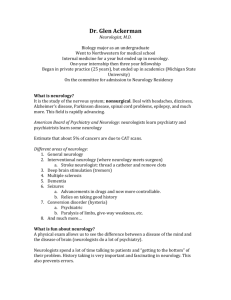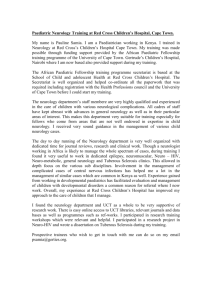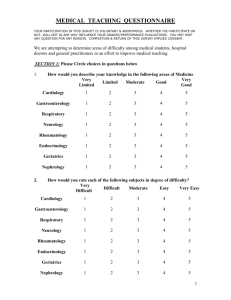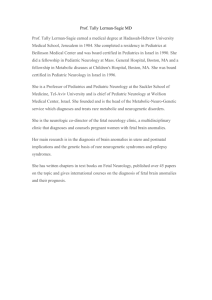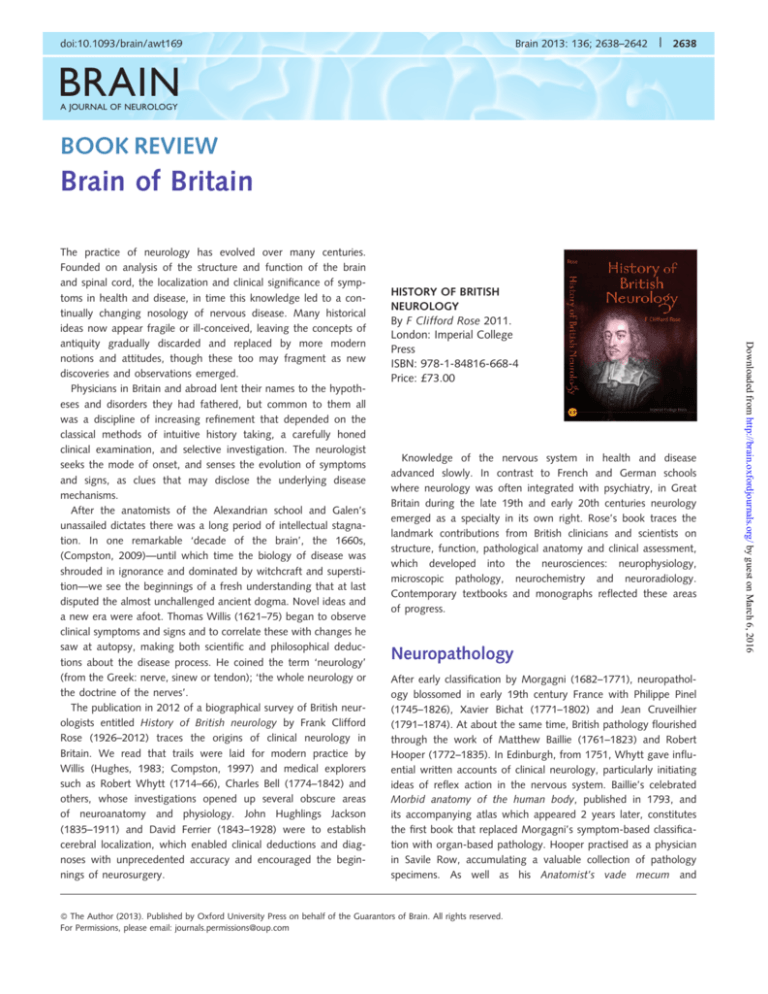
doi:10.1093/brain/awt169
Brain 2013: 136; 2638–2642
| 2638
BRAIN
A JOURNAL OF NEUROLOGY
BOOK REVIEW
Brain of Britain
HISTORY OF BRITISH
NEUROLOGY
By F Clifford Rose 2011.
London: Imperial College
Press
ISBN: 978-1-84816-668-4
Price: £73.00
Knowledge of the nervous system in health and disease
advanced slowly. In contrast to French and German schools
where neurology was often integrated with psychiatry, in Great
Britain during the late 19th and early 20th centuries neurology
emerged as a specialty in its own right. Rose’s book traces the
landmark contributions from British clinicians and scientists on
structure, function, pathological anatomy and clinical assessment,
which developed into the neurosciences: neurophysiology,
microscopic pathology, neurochemistry and neuroradiology.
Contemporary textbooks and monographs reflected these areas
of progress.
Neuropathology
After early classification by Morgagni (1682–1771), neuropathology blossomed in early 19th century France with Philippe Pinel
(1745–1826), Xavier Bichat (1771–1802) and Jean Cruveilhier
(1791–1874). At about the same time, British pathology flourished
through the work of Matthew Baillie (1761–1823) and Robert
Hooper (1772–1835). In Edinburgh, from 1751, Whytt gave influential written accounts of clinical neurology, particularly initiating
ideas of reflex action in the nervous system. Baillie’s celebrated
Morbid anatomy of the human body, published in 1793, and
its accompanying atlas which appeared 2 years later, constitutes
the first book that replaced Morgagni’s symptom-based classification with organ-based pathology. Hooper practised as a physician
in Savile Row, accumulating a valuable collection of pathology
specimens. As well as his Anatomist’s vade mecum and
ß The Author (2013). Published by Oxford University Press on behalf of the Guarantors of Brain. All rights reserved.
For Permissions, please email: journals.permissions@oup.com
Downloaded from http://brain.oxfordjournals.org/ by guest on March 6, 2016
The practice of neurology has evolved over many centuries.
Founded on analysis of the structure and function of the brain
and spinal cord, the localization and clinical significance of symptoms in health and disease, in time this knowledge led to a continually changing nosology of nervous disease. Many historical
ideas now appear fragile or ill-conceived, leaving the concepts of
antiquity gradually discarded and replaced by more modern
notions and attitudes, though these too may fragment as new
discoveries and observations emerged.
Physicians in Britain and abroad lent their names to the hypotheses and disorders they had fathered, but common to them all
was a discipline of increasing refinement that depended on the
classical methods of intuitive history taking, a carefully honed
clinical examination, and selective investigation. The neurologist
seeks the mode of onset, and senses the evolution of symptoms
and signs, as clues that may disclose the underlying disease
mechanisms.
After the anatomists of the Alexandrian school and Galen’s
unassailed dictates there was a long period of intellectual stagnation. In one remarkable ‘decade of the brain’, the 1660s,
(Compston, 2009)—until which time the biology of disease was
shrouded in ignorance and dominated by witchcraft and superstition—we see the beginnings of a fresh understanding that at last
disputed the almost unchallenged ancient dogma. Novel ideas and
a new era were afoot. Thomas Willis (1621–75) began to observe
clinical symptoms and signs and to correlate these with changes he
saw at autopsy, making both scientific and philosophical deductions about the disease process. He coined the term ‘neurology’
(from the Greek: nerve, sinew or tendon); ‘the whole neurology or
the doctrine of the nerves’.
The publication in 2012 of a biographical survey of British neurologists entitled History of British neurology by Frank Clifford
Rose (1926–2012) traces the origins of clinical neurology in
Britain. We read that trails were laid for modern practice by
Willis (Hughes, 1983; Compston, 1997) and medical explorers
such as Robert Whytt (1714–66), Charles Bell (1774–1842) and
others, whose investigations opened up several obscure areas
of neuroanatomy and physiology. John Hughlings Jackson
(1835–1911) and David Ferrier (1843–1928) were to establish
cerebral localization, which enabled clinical deductions and diagnoses with unprecedented accuracy and encouraged the beginnings of neurosurgery.
Book Review
Texts
John Cooke (1756–1838) wrote the first systematic text of clinical
neurology and its history (Cooke, 1820–1823). More specialized
accounts of neurology appeared later in the 19th century in
Europe with the outstanding books of Moritz Heinrich Romberg
(1795–1873), Carl Wernicke (1848–1905) and Hermann
Oppenheim (1858–1919). But certainly none matched two texts
from Great Britain: A manual of disease of the nervous system
(1886) by Sir William Gowers (1845–1915) and the personal,
comprehensive and descriptive contribution of Samuel Kinnier
Wilson (1878–1937), Neurology (1940). Both furnished unparalleled one-author descriptions and historical perspectives covering
the whole subject; each is still frequently consulted. New specialized monographs also flourished.
| 2639
Cerebral localization
There was a further ‘Memorable decade in the history of neurology’ (Spillane, 1974) between 1874–84. Shortly after the investigations by Gustav Fritsch (1837–1927) and Eduard Hitzig
(1839–1907), the doctrine of cerebral localization was pioneered
in Britain by Jackson and Ferrier. Jackson’s ideas about epilepsy,
the hierarchical organization of functions of the brain and localization—‘Localization of function is the law of all organization’—
still permeate neurological thinking (Taylor, 1958; Critchley and
Critchley, 1998; York and Steinberg, 2011). And, crucially, his
friend Ferrier carried out original experiments on cerebral localization at the West Riding Pauper and Lunatic Asylum in Wakefield
under James Crichton-Browne (1840–1938; Pearce and Lees,
2013). A precise map for motor functions was drawn based on
low intensity Faradic stimulation of animal cortex; the same areas
when lesioned produced a deficit that corresponded to the results
of stimulation. High intensity stimulation induced seizures which
confirmed Jackson’s belief that epilepsies were discharging lesions
of the different cerebral centres. This was original, experimental
medicine of the highest order. Indeed, E.D. Adrian (1889–1977) in
1939 referred to this time as: ‘a classical period in the history of
medicine, the period when neurology became a science’.
It therefore occasions no surprise that British neurologists were a
major influence on the formative decades of American neurology,
which evolved from the 1870s with the American Neurological
Association (1874) inspired by William Alexander Hammond
(1828–1900) and Silas Weir Mitchell (1829–1914). They were succeeded by George Beard (1839–83), Tracy Putnam (1894–1975),
who with H. Houston Merritt (1902–79) discovered phenytoin
(Epanutin). However, distinguished American physicians such as
James Jackson Putnam (1846–1918) and Stanley Cobb
(1887–1968) independently nurtured the specialty but were slow
to accept the separation of neurology from William Osler’s
(1849–1919) monistic internal medicine, and neuropsychiatry.
Neurophysiology
In considering Rose’s The history of British neurology, we should
remember pioneers such as Rudolf Virchow (1821–1902),
Hermann von Helmholtz (1821–94), Charles-Édouard Brown
Séquard (1817–94) and Claude Bernard (1813–78) who established the scientific roots of modern medicine. The fundamental
concept of reflex function stemmed from Whytt, Bell and Marshall
Hall (1790–1857). In physiology, Sir Charles Sherrington
(1857–1952) and Adrian later were acclaimed worldwide as instigators of basic neuroscience. In The discovery of reflexes (1960),
E.G.T. Liddell included chapters on important area of progress: the
nerve cell and the microscope; animal electricity; experimental
approaches; and ‘Sherrington and his times’ (Creed et al.,
1932), to which we may add neurotransmission, though of
course all are interrelated. Sherrington explained the propagation
of the nerve impulse through synapses, and defined the efferent
and afferent functions of nerve and muscle and the physiology of
the stretch reflex. In The integrative action of the nervous system
(1906) he showed that regulation of reflex activity required an
Downloaded from http://brain.oxfordjournals.org/ by guest on March 6, 2016
A compendious medical dictionary &c (1798), he wrote and illustrated The morbid anatomy of the human brain, being illustrations of the most frequent and important organic diseases to
which that viscus is subject (1826); in this work he categorized
the principal morbid changes in the brain: inflammation; tumours
(with eight subdivisions); disease without tumefaction; morbid collections of fluids between membranes and in the cavities; and
extravasated fluids.
Outside the UK, the new compound microscope, techniques for
tissue fixation and embedding, and the use of Benedikt Stilling’s
(1810–79) microtome were essential inventions for describing
the histology of the nervous and other systems. Robert Remak
(1815–65; Pearce, 1996) and his former student, Rudolph Albert
von Kölliker (1817–1905) initiated the application of these methods to neural tissue. However, the crucial demonstration of the
ways in which axons and neurones waste in various degenerative
diseases was the work of the Augustus Volney Waller (1816–70)
in England and Theodor Schwann (1810–82) in Germany. Born in
Kent in 1850, Waller reported to the Royal Society that if nerves
are cut, the distal segment containing axis cylinders disconnected
from the nerve cell undergoes degeneration (Waller, 1850). As the
cell body and proximal stump remain intact for a long period,
Waller inferred that the nerve cells nourish nerve fibres. This
made it possible to trace nerve fibres and, hence, their diseases.
In 1894, a surgeon at Lincoln, Joseph Swan (1791–1874) demonstrated regeneration in the sciatic nerve after section. This complemented the studies of peripheral nerve cells described by Georg
Prochaska (1749-1820) and later by Schwann in 1839 (Karenberg,
2000). Combined with Auguste Forel’s seminal studies, Waller’s
work was a necessary foundation for the ‘neurone theory’.
Sir Charles Bell also made progress in surgical and neural pathology, as did the ‘artist-pathologist’ Robert Carswell (1793–1857)
who became first the professor of Pathological Anatomy at
University College, London in 1828. Carswell’s description is in
the splendidly illustrated publication of 1838. Of his 1034 paintings, 99 were of the brain and cord and plate 4 in the atlas depicts
the first images of of multiple sclerosis several decades before
Jean-Martin Charcot’s (1825–93) De la sclérose en plaques
(1868), and Walter Moxon’s (1836–86) Eight cases of insular
sclerosis of the brain and spinal chord (1875).
Brain 2013: 136; 2638–2642
2640
| Brain 2013: 136; 2638–2642
Clinical discipline
Amongst early 20th century clinicians, Henry Head (1861–1940),
Gordon Holmes (1876–1965), Sir Francis Walshe (1885–1973), Sir
Charles Symonds (1890–1978) and Lord Brain (1895–1966) in
London established an inimitable quality of clinical practice and
teaching. The rigours they imposed were peculiarly British: ‘To
be trained by him [Holmes] was a severe but most salutary discipline’, remarked Walshe. Similarly, Macdonald Critchley
(1900–97) observed: ‘He could coax physical signs out of a patient
like a Paganini on the violin’. From their painstaking clinical precision these neurologists inferred and tested much of basic neurological physiology and clinico-pathological correlation presented in
their respective texts. Their writings still have compelling vitality,
disarming candour and fertile ideas. Many of their maxims survive
to this day.
History of British neurology
Most of these landmarks of neurological progress are sketched in
the History of British neurology (2012), the last of Rose’s prolific
list of publications. Rose had a lifelong interest in medical history
and was a founding editor (1992) of the Journal of the History
of Neurosciences. A great organizer of international conferences
he ably edited a host of monographs from their contributed
manuscripts. Rose covered variations of this book in: A short
history of neurology: the British contribution 1660–1910 (1999),
and Twentieth century neurology: the British contribution (2001).
His Historical overview of British neurology also appeared in
Chapter 39 of the Handbook of clinical neurology (2010).
The contents of History of British neurology include brief
notes on British neurology before Willis, a substantial chapter on
Willis: ‘the founder of neurology’ and Rose then summarizes the
works of neurological exponents of the 17th, 18th and first half of
the 19th centuries. He describes advances made at the National
Hospital Queen Square covering many neurologists and neurosurgeons mentioned above, and he paints an informative picture
of the development of the specialty in London. There follows
biographical accounts of the latter part of the 19th and 20th
centuries. Having considered these cardinal figures, he systematically observes the evolution of knowledge and techniques, again
highlighting the most important exponents. Neurosurgery, head
injuries, paediatrics, neuropathology and neurophysiology are discussed in turn, ending with investigators of other neurosciences,
mainly of the last 70 years.
Rose’s book has to be set against a daunting collection of earlier
histories of clinical neuroscience. Walther Riese’s A history of
neurology (1959) is a respected, quasi-philosophical monograph
omitting biographical data. Clarke and O’Malley’s The human
brain and spinal cord, 1968 (Norman, 1996), deals with the evolution of predominantly anatomical and histological knowledge
from Graeco-Roman times to the 20th century. Garrison’s history
of neurology by Lawrence McHenry (1969) provided a more comprehensive picture. Marvellously succinct but more accurate biographies arranged by discipline are found in Haymaker and
Schiller’s The founders of neurology (1970). For a scholarly and
detailed appraisal and source of reference, the neurologist cannot
improve on J.D. Spillane’s The doctrine of the nerves (1981). The
dictionary-like Morton’s medical bibliography by Jeremy Norman
(1991) catalogues significant writings and articles throughout the
history of medicine, many neurological. Those still sympathetic
to the nostalgia of eponyms will find a selection in Neurological
eponyms by Koehler, Bruyn and Pearce (2000).
History of British neurology provides the reader with a broad
(perhaps too broad) account, mainly centred on individual neurologists, their beginnings, careers and publications. Some sections,
such as those on Bell, Jackson, Head, Kinnier Wilson and Critchley
(whom he greatly admired) are refreshingly spiced with anecdotes
to reveal glimpses of their personal lives and idiosyncrasies. They
tell of the personalities behind the names. Others are more drab
factual accounts. Some are no more than a pallid outline, such
as a single page on Lord Brain, and a solitary paragraph on the
remarkable Thomas Young (1773–1829), ‘The last man who
knew everything’ (Robinson, 2006). Robert Boyle (1627–91),
Sir Christopher Wren (1632–1723), Robert Hooke (1635–1703)
and many of the ‘natural philosophers’ recorded here made
huge scientific contributions, but in the main they were remote
from neurology and one wonders whether they should have been
included.
Although the British contribution is impressive, how did this
relate to progress of comparable importance across Europe?
Important links did exist between the neurologist physicians [for
instance, both Jackson and Sir John Russell Reynolds (1828–96)
with Charcot], and both awareness and ignorance of continental
studies merit explanation not found here. In France, advances
were made under Charcot, Pierre Marie (1853–1940), Guillaume
Duchenne (1806–75), Joseph Babinski (1857–1932), Georges
Gilles de la Tourette (1857–1904) and their distinguished colleagues, many of whom presented at The Société de Neurologie
Downloaded from http://brain.oxfordjournals.org/ by guest on March 6, 2016
intact cord with interaction of neighbouring segments and reciprocal inhibition and facilitation of agonists and antagonists for
normal motor and postural functions. In 1932, Adrian and
Sherrington shared Nobel Prize for work on the function of neurons. In the same period, Sir Henry Hallett Dale (1875–1968) and
Otto Loewi (1873–1961) were recognized for their work on chemical transmission between nerves (Pearce, 2009).
This new physiology connected neatly with Camillo Golgi’s
(1843–1926) silver staining techniques (‘the black reaction’) to
demonstrate the nexus between dendrites, neurons and axons,
and with Santiago Ramón y Cajal’s (1852–1934) demonstration
that individual neurons are the fundamental units of the nervous
system (the neuron doctrine). All neural organization depended on
the conducted nerve impulses that connected axons, dendrites and
the cell bodies. Together Cajal and Golgi received the Nobel Prize
in 1906 for their studies of the structure of the nervous system
Against the background of interest in the electrical activity of
the brain, Adrian developed techniques for recording electrical
activity from the peripheral nerve fibres. Demonstration of intracellular recordings eventually founded studies of neural transmission by the 1963 Nobel laureates Sir Andrew Huxley (1917–2012),
Sir Alan Hodgkin (1914–1998) and Sir John Eccles (1903–1997).
Book Review
Book Review
| 2641
Robert Graves’s (1895–1985) account of transient ischaemic
attacks, Walshe’s strident critique of Wilder Penfield’s
(1891–1976) homunculus are but a few examples where we
miss the original words. If this book repeats much of the author’s
previous writings, this may be forgiven since he leaves us with a
useful collection of essentially biographical notes on a wide range
of neuroscientists who sculpted modern neurology. Rose and
Bynum’s Historical aspects of the neurosciences (1982) was a
more satisfactory and authoritative work.
Biographical collations subsume inextricably interrelated ingredients: the life of the man or woman described, and the results they
have achieved (Pearce, 2007). Certain anecdotes of personal
eccentricities and notoriety enliven Rose’s account and help us
to understand their subjects’ successes and failures and to put
them in the context of their individual achievements. He leaves
us a competent historical précis that should encourage neuroscientists and aspiring neurologists to seek earlier works and ideas.
For more penetrating, comprehensive texts illuminating the routes
from each discovery along the pathways of medical practice, the
reader will have to consult other publications. A cultivation of the
past bears its own fruits. Rose’s biographies afford the chance to
see which ideas and discoveries developed, flourished and sometimes were also destroyed by advancing experiments and consequent knowledge.
J. M. S. Pearce
Advance Access publication June 29, 2013
References
Carswell R. Illustrations of the elementary forms of disease. Pl 1V fig1.
London: Longman; 1838.
Compston A. Dr Thomas Willis and the origins of clinical neuroscience.
Cambridge: Plumridge; 1997.
Compston A. A short history of clinical Neurology. In: Brain’s diseases of
the nervous system. New York, NY: Oxford University Press; 2009.
p. 3–26.
Cooke J (1820–1823). A treatise on nervous diseases. Vol, 3. p. 469.215;
235. Longman, Hurst, Rees, Orme and Brown, London. Facsimile edition. Classics of Neurology and Neurosurgery 1984. Facsimiles of
1820, 1821, & 1823 originals. Publication: 1984.
Creed RS, Denny Brown D, Eccles JC, Liddell EG, Sherrington CS. Reflex
activity of the spinal cord. Oxford: Clarendon Press; 1932.
Critchley M, Critchley EA. John Hughlings Jackson. Father of English
neurology. Oxford: Oxford University Press; 1998.
Hughes T. Thomas Willis 1621-1675: His Life and Work (Eponymists in
Medicine.). London: Royal Society of Medicine; 1983.
Jackson JH. In: Taylor J, editor. Selected writings of JH Jackson. Vol. 2.
[1931 Reprinted]. London: Staples Press; 1958.
Karenberg A. The Foundation of the Society of German Neurologists in
1907 and the first two presidents. J Hist Neurosci 2009; 18: 211–213.
Karenberg A. Theodor Schwann. In: Koehler P, Bruyn G, Pearce JMS,
editors. Neurological Eponyms. New York: Oxford University Press;
2000. p. 44–50.
Pearce J M S. Medical Biography: a personal view. J Med Biogr 2007; 15:
1–3.
Pearce JMS. Links between nerves and glands: The story of adrenaline.
Adv Clin Neurosci Rehabil 2009; 9: 22–29.
Pearce JMS. Remak, father and son. Lancet 1996; 347: 1669–70.
Downloaded from http://brain.oxfordjournals.org/ by guest on March 6, 2016
de Paris. In Germany, neurology was closely bound to psychiatry
(Karenberg, 2009). The Society of German Neurologists was
founded in 1907, the culmination of advances made inter alia
by Wilhelm Erb (1840–1921), Wernicke, Robert Remak
(1815–65) and Romberg. British neurologists were familiar with
their work and with Oppenheim, Arnold Pick (1851–1924),
Cecile (1875–1962) and Oskar (1870–1959) Vogt, Alois
Alzheimer (1864–1915), Otfried Förster (1873–1941), Kurt
Goldstein (1878–1965) and the German Carl Friederich Otto
Westphal (1833–90). What, we are left to wonder, was their influence on neurology in Britain and vice versa? They may have
lacked the analytical refinement of contemporary English clinicians,
but they continued the tradition of describing new syndromes and
correlating them with sophisticated neuropathology and speculating about pathogenesis.
We are reminded that in Britain, neurology was more intricately
linked to general medicine, and remains so. It was one of the first
specialties to develop in the mid 19th century. In 1886 the
Neurological Society of London was founded, with Jackson as its
first president. Kinnier Wilson was the first ‘physician in charge of
a neurological department’ (at the Westminster hospital),
appointed in the second decade of the 20th century. Most of
the physicians at Queen Square were general physicians with a
special interest in neurology; indeed most were appointed as general physicians in their various teaching hospitals. The separation
of neurology from psychiatry then widened in Britain, in contrast
to Germany and the USA where these disciplines were often
fused. The underlying British themes were clinical precision and
observation, and clinico-pathological correlation. These corresponded to the approach of Charcot’s school and were inseparably
linked to cerebral localization initiated by Fritsch and Hitzig in
Germany and crucially by Ferrier’s original Wakefield experiments.
Although Rose mentions these advances, his text concentrates
more on the individual exponents than on the evolving theme of
scientific progress and knowledge aimed at showing how the brain
worked, and what was the diagnostic significance of the clinical
signs observed. We search in vain for a story of the vision possessed by most great experimenters.
The coverage is patchy. Migraine, one of Rose’s favourite topics
about which he organized several conferences, inexplicably receives sparse mention and no specific account of the development
of aetiological concepts and treatments. Indeed Edward Liveing
(1832–1919), whose 1873 monograph On megrim, sick headache, and some allied disorders was the most important on the
subject for more than 60 years is not mentioned. The work of
Robert Bentley Todd (1809–60), one of the most original if disputatious physicians of the mid 19th century, is not adequately
described. Jackson acknowledged the Todd and Robertson theory
that post-epileptic paralysis was due to ‘post-paroxysmal exhaustion of the cortical centres’, but this and original quotations from
his writings are not in evidence. There is brief mention of, but no
extract from Kinnier Wilson’s classic 1912 paper in Brain:
‘Progressive lenticular degeneration: a familial nervous disease
associated with cirrhosis of the liver’. Many of the citations are
illuminated only by a brief quotation, too often from a secondary
source; this forfeits the expression and thoughts behind original
descriptions. Gowers’s account of pseudohypertrophic paralysis,
Brain 2013: 136; 2638–2642
2642
| Brain 2013: 136; 2638–2642
Pearce JMS, Lees AJ. Yorkshire’s influence on the foundation of British
Neurology. J Neurol Neurosurg Psychiatry 2013; 84: 6–9.
Robinson A. The last man who knew everything: Thomas Young, the
anonymous polymath who proved Newton wrong, explained how
we see, cured the sick and deciphered the Rosetta Stone among
other feats of genius. New York: Pi Press; 2006.
Spillane JD. A memorable decade in the history of neurology 1874-84-I.
BMJ 1974; 4: 701–706.
Book Review
Waller AV. Experiments on the section of the glossopharyngeal and
hypoglossal nerves of the frog, and observations of the alterations
produced thereby in the structure of their primitive fibres. Philos
Trans R Soc 1850; 140: 423–9.
York GK, Steinberg DA. Hughlings Jackson’s neurological ideas. Brain
2011; 134: 3106–13.
Downloaded from http://brain.oxfordjournals.org/ by guest on March 6, 2016




